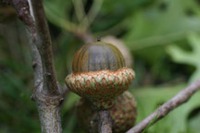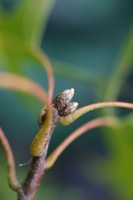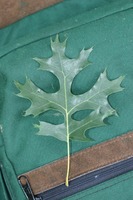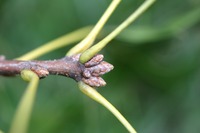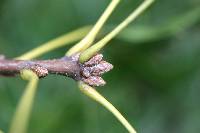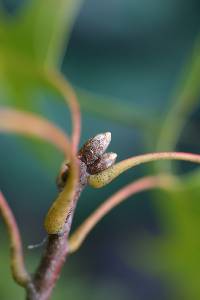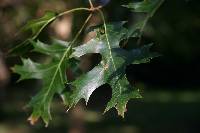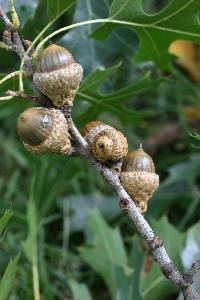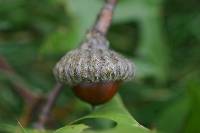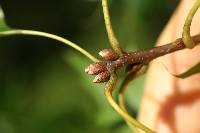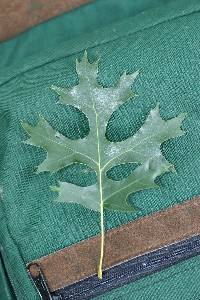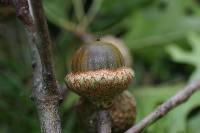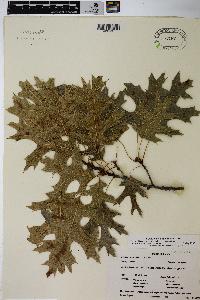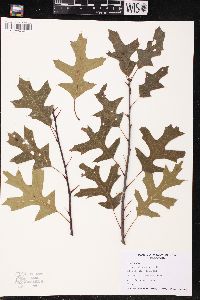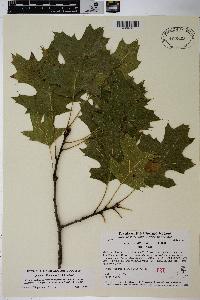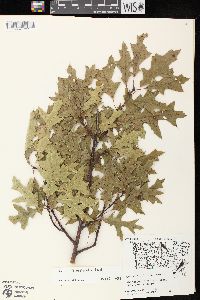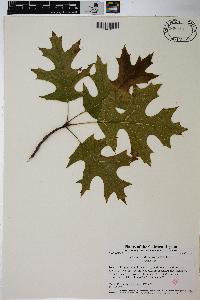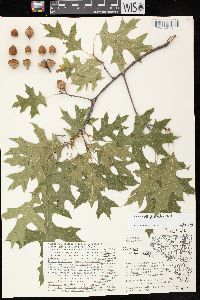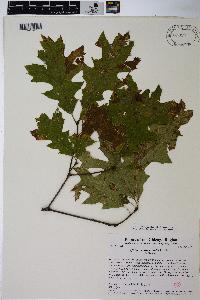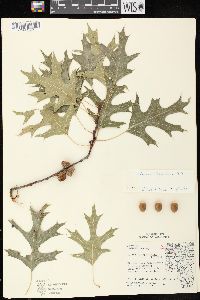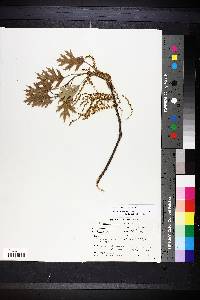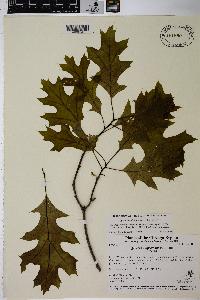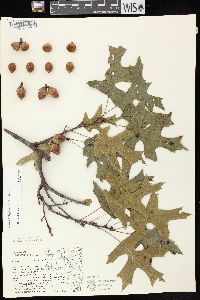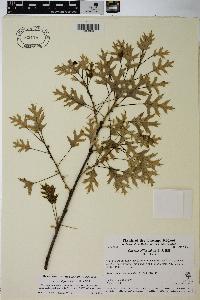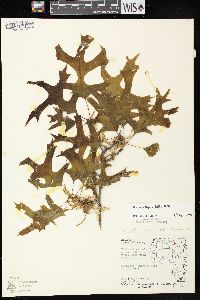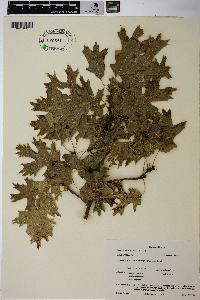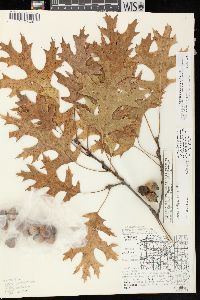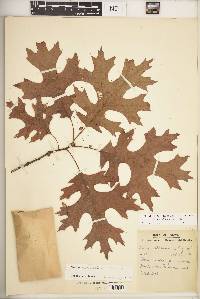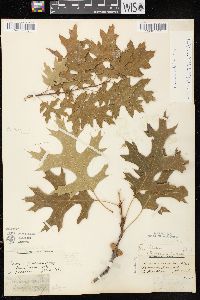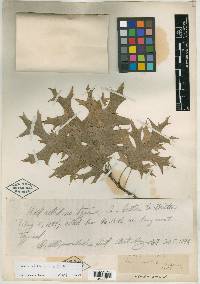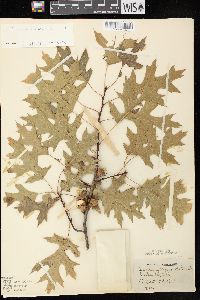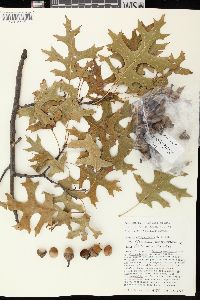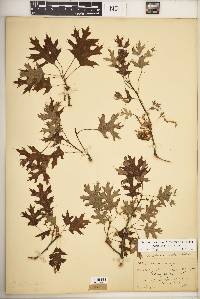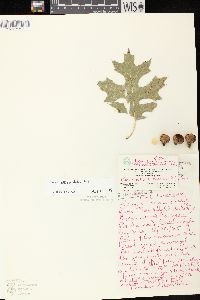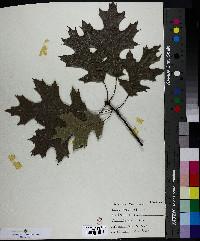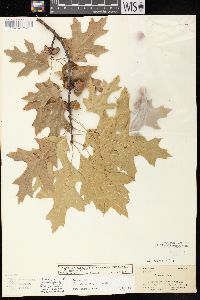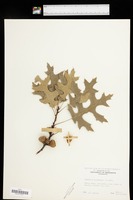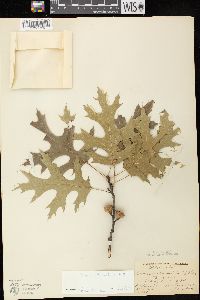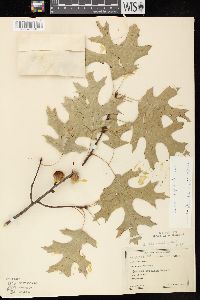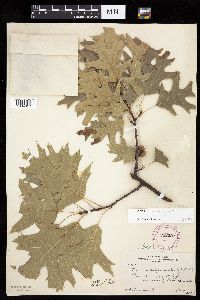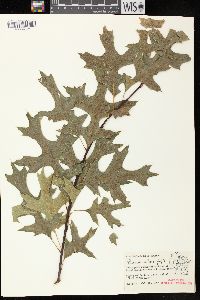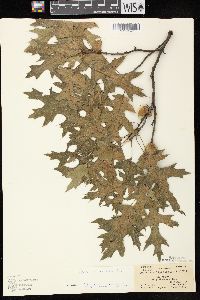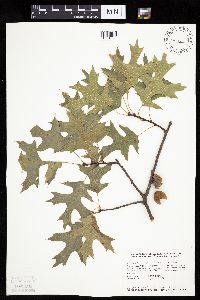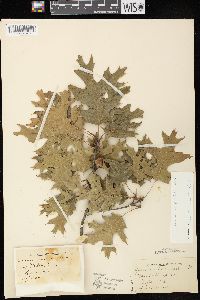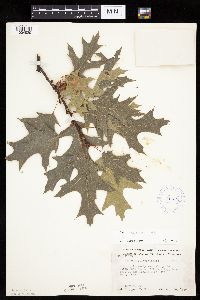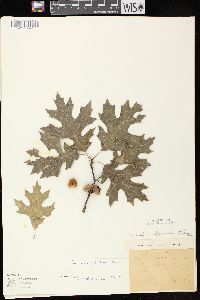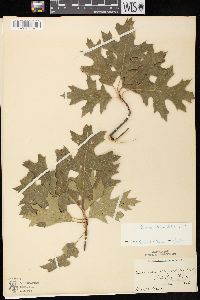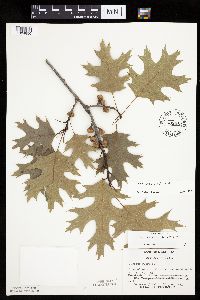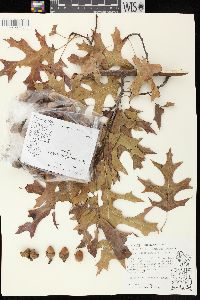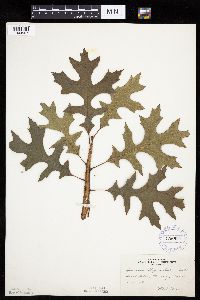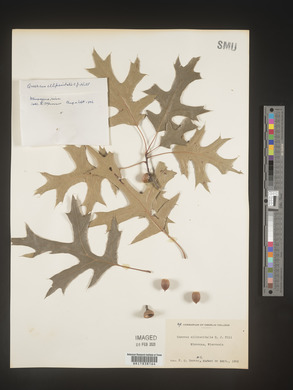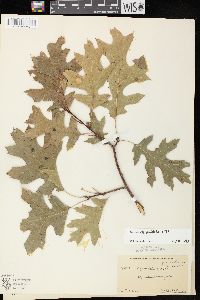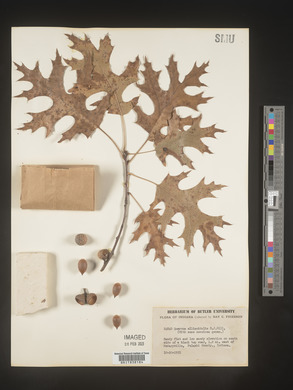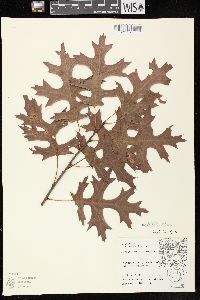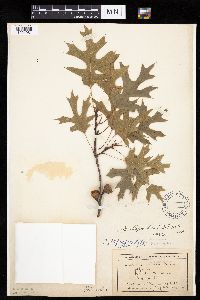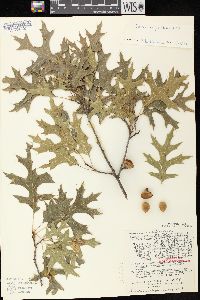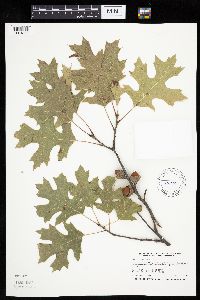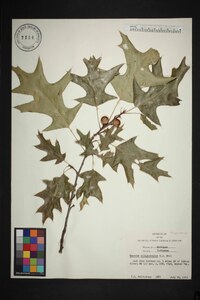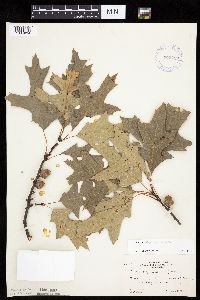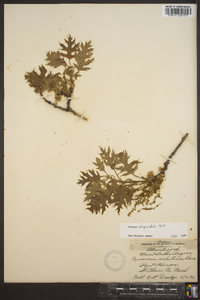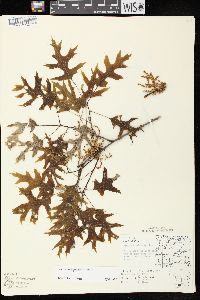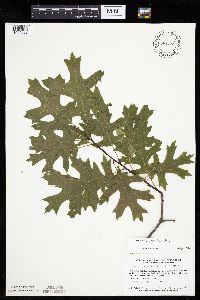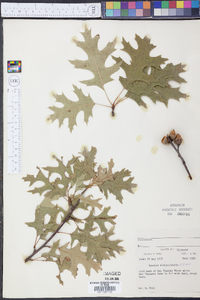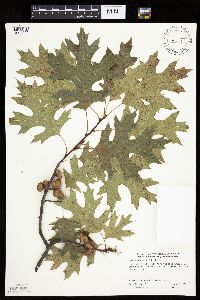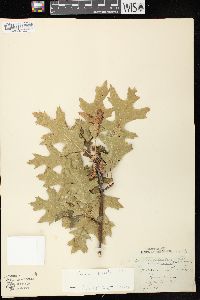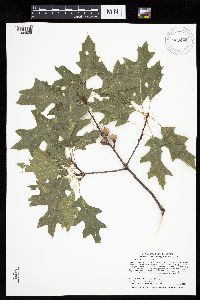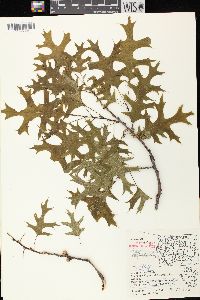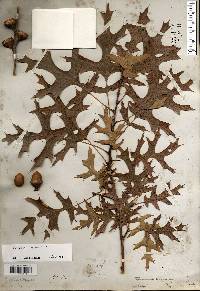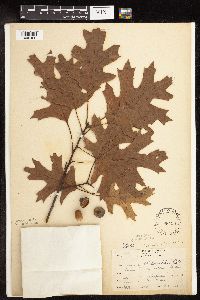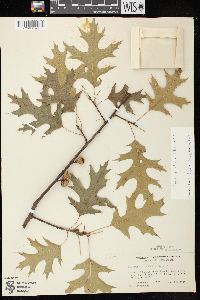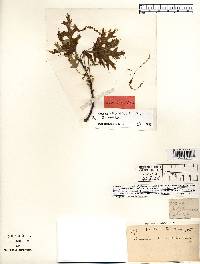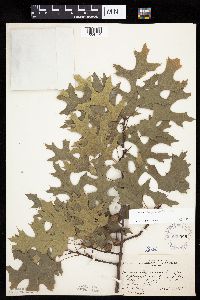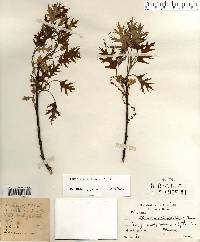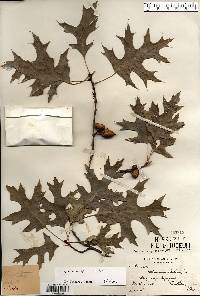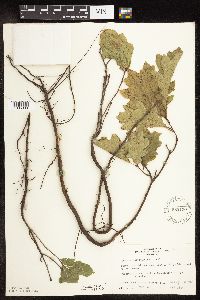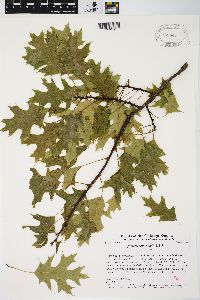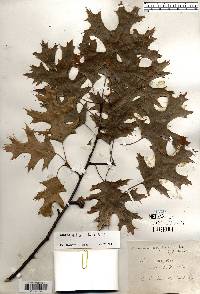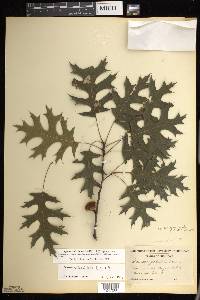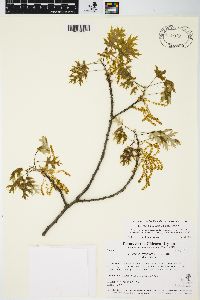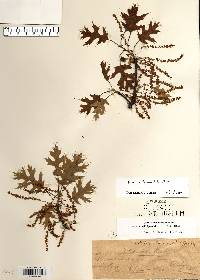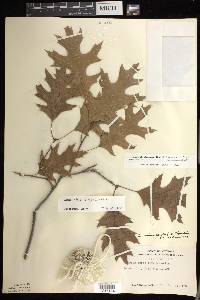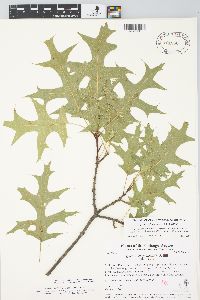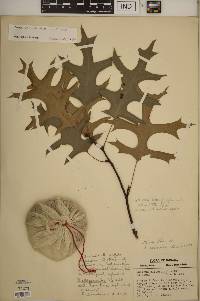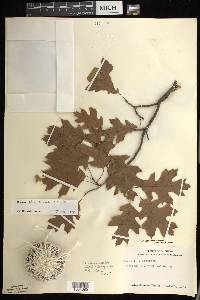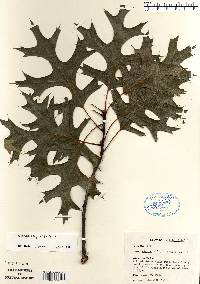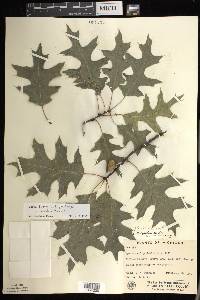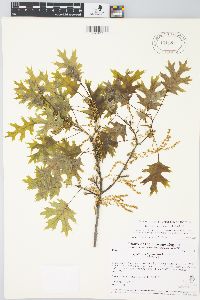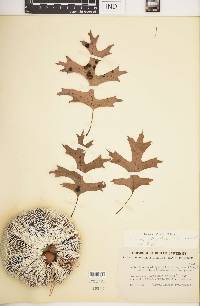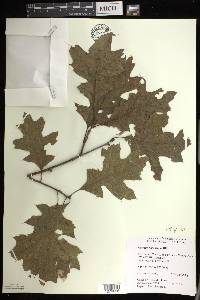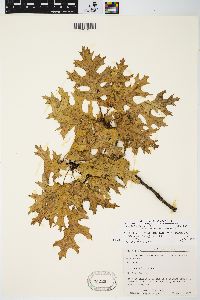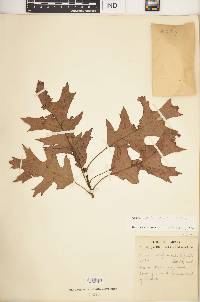
|
|
|
|
Family: Fagaceae
Northern Pin Oak
[Quercus ellipsoidalis var. kaposianensis J.W.Moore] |
Trees , deciduous, to 20 m; lower trunk often with stubs of dead branches. Bark dark gray-brown, shallowly fissured, inner bark orangish. Twigs dark reddish brown, (1-)1.5-3 mm diam., glabrous. Terminal buds dark reddish brown, ovoid, 3-5 mm, often conspicuously 5-angled in cross section, usually silvery- or tawny-pubescent toward apex. Leaves: petiole 20-50 mm, glabrous. Leaf blade elliptic, 70-130 × 50-100 mm, base obtuse to truncate, margins with 5-7 deep lobes and 15-55 awns, lobes distally expanded, sinuses usually extending more than 1/2 distance to midrib, apex acute; surfaces abaxially glabrous except for minute axillary tufts of tomentum, adaxially glossy light green, glabrous, secondary veins raised on both surfaces. Acorns biennial; cup narrowly turbinate to deeply cup-shaped, 6-11 mm high × 10-19 mm wide, covering 1/3-1/2 nut, outer surface reddish brown, puberulent, inner surface light brown, glabrous, rarely with ring of pubescence around scar, scales with straight or slightly concave margins, tips tightly appressed, obtuse or acute; nut ellipsoid to ovoid, rarely subglobose, 10-20 × 9-15 mm, occasionally striate, glabrous, occasionally with 1 or more faint rings of fine pits at apex, scar diam. 4-8 mm. Flowering spring. Dry sandy sites, rarely on moderately mesic slopes or uplands; 150-500 m; Ont.; Ill., Ind., Iowa, Mich., Minn., Ohio, Wis. In many treatments (e.g., E. G. Voss 1972+, vol. 2), Quercus ellipsoidalis is included in Q . coccinea . Variation in fruit morphology has led to recognition of several formae (W. Trelease 1919; see also R. J. Jensen 1986) and one variety ( Q . ellipsoidalis var. kaposianensis , based on specimens from St. Paul, Minnesota, in which the cup tightly encloses the nut for two-thirds its length at maturity). Quercus ellipsoidalis reportedly hybridizes with Q . rubra and Q . velutina . The Menominee used Quercus ellipsoidalis medicinally to treat suppressed menses caused by cold (D. E. Moerman 1986).
Tree 15 - 20 m tall, trunk 30 cm - 1 m in diameter Leaves: alternate, stalked, shiny bright green above, paler beneath, 7.5 - 17 cm long, 6 - 15 cm wide, five to seven bristle-tipped lobes separated by depressions reaching three-quarters of the way to the midvein, tufts of hairs in leaf axils. Foliage turns orange to red to gold-brown in fall. Flowers: either male or female, borne on the same tree (monoecious), male catkins 3.5 - 5 cm long, dark red female flowers solitary or in clusters of two to three near leaf axils. Fruit: an acorn, maturing in two seasons, solitary or in pairs. The cup is stalkless or short-stalked, shaped like a top, covers one-third to half of the nut, and has thin light brown to ash gray scales that are lightly hairy. Nut 1.2 - 2 cm long, elliptic to rounded. Bark: dark gray to dark brown, smooth when young, becoming shallowly furrowed, inner bark pale yellow to orange. Twigs: reddish brown and hairy, becoming grayish brown and smooth when older. Buds: shiny reddish brown, 4 - 7 mm long, egg-shaped. Each terminal bud is surrounded by a cluster of lateral buds. Form: oval to rounded with lower branches drooping and holding onto trunk after death. Similar species: Many species in the red oak group have highly variable, lobed leaves with bristle tips. Quercus rubra has shallowly lobed leaves with a somewhat dull upper surface and a very shallow saucer-shaped acorn cup that covers only the base of the nut. Quercus velutina has leaves with depressions reaching half way to the midvein, inner bark that is bright yellow to orange, and fringed acorn cups that fit loosely and cover one-third to half the nut. The leaves of Quercus shumardii have depressions reaching three-quarters the distance to the midvein, the tufts of hairs at the leaf axils are very prominent, the buds are grayish to yellow, and the acorn cup is saucer-shaped and covers one-third of the nut. Quercus palustris has leaves with U-shaped depressions reaching three-quarters the distance to the midvein, dead branches remaining on the trunk, and a shallow acorn cup covering the base of the small nut. Quercus coccinea has leaves with C-shaped depressions reaching half the distance to the midvein, inner bark that is pink to red, and a reddish brown to orange acorn cup that covers one-third to half the nut, which has concentric rings at the tip. Flowering: May Habitat and ecology: Dry upland woods, near ponds and streams in sandy to gravelly soil. Occurence in the Chicago region: native Notes: In the Chicago Region, this species naturally hybridizes with Q. velutina (Q. x palaeolithicola). Etymology: Quercus is the Latin name for oak. Ellipsoidalis comes from the Latin word meaning elliptic, which refers to the shape of the nut. Author: The Morton Arboretum Middle-sized tree; twigs soon glabrescent; lvs glabrous except for small tufts of stellate hairs in the vein-axils beneath; lateral lobes 2-3 pairs, separated by rounded sinuses, usually extending more than half way to the midvein, usually widened and several- toothed distally; acorn-cup turbinate, 9-14 mm wide, smooth inside, with closely appressed, puberulent scales, covering a third of the 12-20 mm nut. Dry upland soil; s. Mich. and adj. O. to Minn. and sw. Ont. and Mo. Possibly better included in no. 29 [Quercus coccinea M From Flora of Indiana (1940) by Charles C. Deam The distribution of this species in Indiana is not known. It is very difficult to identify in the field unless one is familiar with it because it is easily confused with the scarlet and black oaks. I have specimens from the type tree, from a tree in Lagrange County, and from one in White County. In 1938 R. M. Kriebel made a study of its distribution in Indiana and found it throughout northwestern Indiana and in the northern tier of counties. Hill reported it as locally frequent in Lake County, especially near Liverpool. According to Hill, the tree is found on sandy and clayey uplands. Andrews' report from Monroe County may safely be ignored. …… Indiana Coefficient of Conservatism: C = 4 Wetland Indicator Status: N/A |
|
|
|


